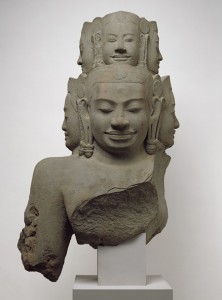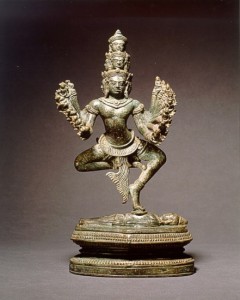 In 1925, French archaeologists excavating near the East Gate of Ankor Tom (the final great monument built in the Angkor complex of Cambodia) found a 900-year-old intricately carved bust of a 7-headed Buddha.
In 1925, French archaeologists excavating near the East Gate of Ankor Tom (the final great monument built in the Angkor complex of Cambodia) found a 900-year-old intricately carved bust of a 7-headed Buddha.
It was missing a head on top, its feet and arms, but the bust indicated it had once been a 10-foot statue of Hevajra, a warrior tantric deity often depicted with 8 arms on each side with feet in a dancing posture.
 The bust was sold to the Metropolitan Museum of Art in New York City, where it remains on display to this day. Nobody has found the remaining parts of the colossus, until Dr. Peter Sharrock took a break from a conference to hike the jungles around Ankor.
The bust was sold to the Metropolitan Museum of Art in New York City, where it remains on display to this day. Nobody has found the remaining parts of the colossus, until Dr. Peter Sharrock took a break from a conference to hike the jungles around Ankor.
All he had to make his way was a single old picture of the 1925 exhibition and a strong groin.
“There was no road, only a sort of animal track into the forest,” he said. “It was pretty unpleasant. There were snakes all over the place, and in the back of my mind was the knowledge that the Khmer Rouge had planted land mines all over Angkor.
“We went on and on, and were about to give up, when finally I spotted something through the trees. We strode through the creepers and thorns, and I realised that I’d seen the carved square corner of the statue’s pedestal. And lo and behold, there were the legs lying beside it.” […]
Hevajra would have been venerated during the reign of Jayavarman VII, emperor of the Khmers at the height of their power, but it is likely the statue was broken up and dumped outside the city walls during a revival of Hinduism in the 14th century. This theory undermines the view that the Khmers followed a compassionate Buddhist philosophy. “It’s something of a tectonic shift in archaeology”, Dr Sharrock said.
The legs are not in supergreat condition, judging from the picture. I’m not seeing much detail in the carving. Perhaps once some conservation is done and the greenery is removed we’ll be able to see more.
The Cambodian government has pledged to excavate the area further in search of the rest of the statue, so keep your 80 fingers crossed.